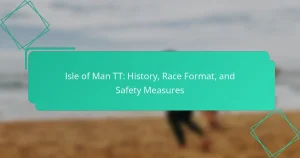The World Rally Championship offers thrilling motorsport action with a packed schedule of international events. Discover the key rallies, including the Monte Carlo Rally and Rally Finland, and learn about the competing teams like Toyota and Hyundai. Understand the scoring system that rewards drivers based on their performance, with opportunities for bonus points in the Power Stage. Explore how technological innovations and fan engagement strategies shape this dynamic competition.

What are the key events in the 2025 World Rally Championship schedule?
The key events in the 2025 World Rally Championship schedule include a series of international rallies held across various countries. The championship typically features around 13 events, starting in January and concluding in November. Notable events include the Monte Carlo Rally, Rally Sweden, and the Rally Finland. Each event varies in terrain, weather conditions, and length, offering unique challenges for teams. The championship also introduces new routes and locations to enhance competition and fan engagement.
How do the event locations impact team strategies?
Event locations significantly influence team strategies in the World Rally Championship. Each venue presents unique terrain, weather conditions, and surface types that teams must adapt to. For example, gravel stages require different vehicle setups compared to asphalt. Teams analyze location-specific data to optimize performance, including tyre choices and suspension settings. Additionally, local knowledge can provide strategic advantages, allowing teams to anticipate challenges and adjust their driving techniques accordingly.
Which events are considered the most challenging?
The most challenging events in the World Rally Championship include the Monte Carlo Rally, Rally Finland, and the Wales Rally GB. These events are known for their tough terrains, unpredictable weather, and high-speed stages. The Monte Carlo Rally features icy roads, while Rally Finland is famous for its jumps and fast gravel stages. The Wales Rally GB presents muddy conditions and narrow roads. Each event tests drivers’ skill, endurance, and adaptability.

What teams are competing in the 2025 World Rally Championship?
The teams competing in the 2025 World Rally Championship include major manufacturers like Toyota, Hyundai, and Ford. Each team fields multiple drivers, contributing to a diverse and competitive landscape. Notable teams may also include privateer entries and emerging brands, enhancing the championship’s dynamic nature.
How do team lineups vary across different events?
Team lineups in the World Rally Championship vary by event type, terrain, and team strategy. Each rally presents unique challenges that influence team composition. For example, teams may prioritise vehicles with specific handling characteristics for gravel versus tarmac events. Additionally, driver experience and co-driver compatibility are critical for navigating diverse rally stages. The scoring system also impacts lineup decisions, as teams aim for points in both manufacturers’ and drivers’ championships.
Which teams have the most historical success in the championship?
The most historically successful teams in the World Rally Championship are Audi, Lancia, and Ford. Audi dominated in the 1980s with its Quattro technology, while Lancia secured multiple titles during the same era. Ford has also made significant contributions with its consistent performances over the years.

How is scoring determined in the World Rally Championship?
Scoring in the World Rally Championship is based on points awarded to drivers and teams based on their finishing positions in each event. The top ten finishers receive points on a scale from 25 for first place to 1 for tenth place. Additional points are awarded for the Power Stage, allowing for potential maximum points per event to reach 30. The cumulative points determine the championship standings for drivers and teams throughout the season.
What are the points distribution rules for different stages?
The World Rally Championship distributes points across various stages based on finishing positions. Points are awarded to the top ten finishers in each stage, with the winner receiving 25 points, second place 18 points, and so on down to 1 point for the tenth position. Additionally, bonus points are awarded for the Power Stage, providing extra incentives for drivers to perform well in that segment. This scoring system encourages competitive racing throughout the event.
How does the scoring system influence team tactics?
The scoring system significantly influences team tactics by prioritising speed and consistency. Teams must balance aggressive driving with risk management to maximise points. The point distribution rewards not only race wins but also consistent finishes, encouraging strategic decisions throughout the championship. This dynamic leads teams to adapt their approaches based on current standings, weather conditions, and vehicle performance.

What are the technological innovations shaping the 2025 World Rally Championship?
Technological innovations shaping the 2025 World Rally Championship include advanced hybrid powertrains, enhanced telemetry systems, and improved safety features. Hybrid powertrains will optimise performance while reducing emissions. Enhanced telemetry systems allow real-time data analysis, improving strategy and vehicle performance. Safety features will incorporate cutting-edge materials and designs, ensuring driver protection. These innovations reflect the championship’s commitment to sustainability and safety.
How do these innovations affect vehicle performance?
Innovations significantly enhance vehicle performance in the World Rally Championship. Advanced technologies improve handling, acceleration, and durability, allowing teams to optimise their vehicles for various terrains. For instance, lightweight materials reduce overall weight, enhancing speed. Additionally, improved aerodynamics increase stability at high speeds, leading to better control during races. Enhanced tyre designs offer superior grip, providing better traction on diverse surfaces. Overall, these innovations contribute to faster lap times and improved competitive edge for teams.
Which teams are leading in the adoption of new technologies?
The leading teams in adopting new technologies in the World Rally Championship include Toyota Gazoo Racing, Hyundai Shell Mobis WRT, and M-Sport Ford. These teams leverage advanced telemetry, hybrid systems, and data analytics to enhance performance and strategy. Toyota, for instance, utilises cutting-edge hybrid technology, while Hyundai focuses on data-driven decision-making during events. M-Sport Ford is recognised for integrating innovative vehicle dynamics software.

What are the unique challenges of rally racing compared to other motorsports?
Rally racing presents unique challenges such as varied terrain, unpredictable weather, and limited service time between stages. Unlike circuit racing, which has a consistent track, rally drivers must adapt to constantly changing conditions. This requires exceptional skill in navigation and vehicle control. Additionally, the reliance on co-drivers for pace notes adds complexity to the competition. The combination of these factors creates a distinct experience that sets rally racing apart from other motorsports.
How do environmental conditions affect rally events?
Environmental conditions significantly impact rally events by affecting vehicle performance and driver strategy. Weather, terrain, and altitude influence tyre choice, engine power, and handling. For example, wet conditions may lead to lower grip levels, requiring drivers to adjust their driving style. Additionally, high altitude can reduce engine efficiency, affecting speed and acceleration. Teams must adapt to these variables to optimise their performance during the World Rally Championship.
What are the safety measures implemented for participants?
The World Rally Championship implements rigorous safety measures for participants. These include mandatory safety gear, vehicle safety standards, and comprehensive medical support. Each team must adhere to strict regulations regarding vehicle modifications to enhance safety. Additionally, regular safety briefings are conducted to prepare drivers and crew for potential risks. Emergency response teams are stationed at all stages to ensure quick assistance if needed.

How do fan engagement strategies differ across regions?
Fan engagement strategies in the World Rally Championship vary significantly across regions due to cultural preferences and local motorsport popularity. In Europe, fan engagement often includes immersive experiences like pit tours and meet-and-greets with drivers. In contrast, regions like Asia focus on digital engagement through social media and online content.
The event schedule also influences engagement; European events frequently feature multiple-day formats that allow for deeper fan interaction. Conversely, single-day events in other regions may limit engagement opportunities. Teams adapt their strategies based on local fan demographics; for instance, some teams prioritise merchandising in markets with high brand loyalty.
Scoring systems can also affect engagement, as fans in regions with a strong understanding of rally scoring may engage more deeply with the sport. Overall, regional differences shape how teams and organisers connect with fans, enhancing the overall experience of the World Rally Championship.
Which platforms are most effective for rally fans?
Social media platforms, particularly Instagram and Twitter, are most effective for rally fans. These platforms provide real-time updates, fan engagement, and behind-the-scenes content. YouTube also offers extensive coverage through highlights and analysis. Facebook groups foster community discussions among enthusiasts. TikTok appeals to younger fans with creative rally content. Each platform serves unique purposes, enhancing the overall rally experience.
How do local cultures influence fan interactions with the championship?
Local cultures significantly shape fan interactions with the World Rally Championship by influencing behaviours, traditions, and expectations. Cultural values dictate how fans engage with events, from celebrating local drivers to participating in unique rituals. For instance, in regions with a strong motorsport heritage, fans often display heightened enthusiasm and loyalty, creating a vibrant atmosphere. Additionally, local customs can affect attendance patterns, with communities rallying around events that resonate with their identity. This cultural interplay enriches the championship experience for both fans and participants, fostering a deeper connection to the sport.
What are best practices for following the World Rally Championship effectively?
To follow the World Rally Championship effectively, prioritise staying updated on the event schedule, team standings, and scoring systems. Regularly check official sources for real-time information and results. Engage with fan communities for insights and discussions. Utilise mobile apps for notifications on stages and results. Familiarise yourself with each team’s strategies and driver profiles to enhance your viewing experience.


